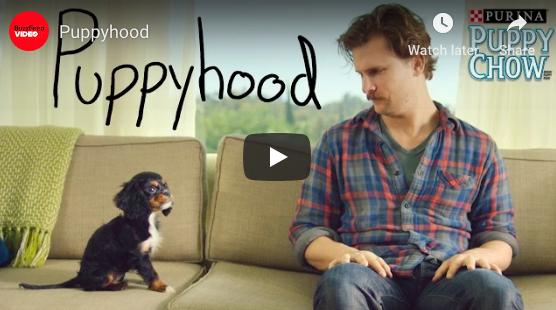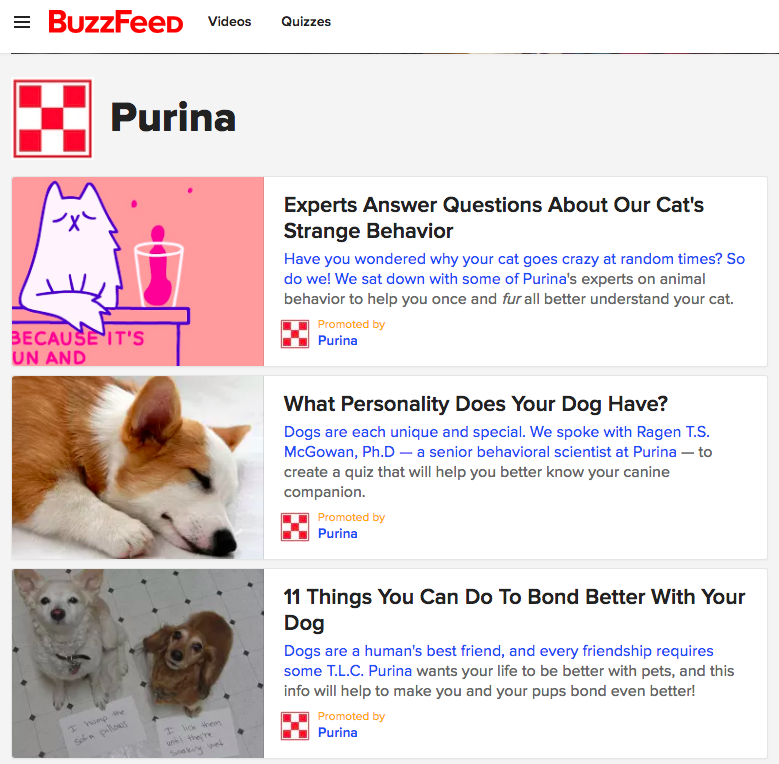According to a recent survey, most people are not pleased with their ad experiences across social media (45%), retail websites (36%) and news aggregators (34%). In fact, more than 51% of them believe that the digital universe should be home to fewer ads, since most pop-ups heavily interfere with the content, interrupt shopping experiences, take up the entire screen and increase loading time.
With the evolution of the advertising landscape, brands are becoming more focused on creating a user experience that matches the customers’ expectations and maximizes their ability to monetize.
Here’s when native advertising comes in.
What is native advertising?
Native advertising is sponsored content that blends in with the editorial environment of a platform to influence customers in a granular, discrete way. For example, promoted tweets are tightly woven within the Twitter layout, making them look exactly like regular tweets that can be favorited, shared and replied to.

Source: contentmarketinginstitute
Unlike traditional banner ads or pop-ups, native ads are highly targeted, mobile-friendly and not disruptive to the user experience. As a result, they perform much better in terms of engagement, viewability, reach and click-through-rate. Nearly 54% of marketers also believe that native advertising (especially on social media) will become the most valuable revenue stream for a brand in the next 2 years.

Source: thinkwithgoogle
Despite being a fairly new concept, native ads are being widely used to drive conversions, attract new customers, and increase brand awareness. Currently, 65% of businesses have set aside a budget of $1,000 to $25,000 for running native ads within a user’s content feed, recommendation modules/widgets, search results and catalogue listings.
In 2015, Purina, an American pet food brand, teamed up with Buzzfeed to create a native advertising campaign that highlights the unbreakable bond between a puppy and a man. Moving away from the 30-second TV commercial format, the 3.5-minute short film relies on strong storytelling and improv-heavy format to engage viewers and create brand awareness. Overall, the video doesn’t appear to be an ad, and comes across as something you’d share with a dog-loving friend.
Purina used multiple digital channels to promote the video that garnered 22 million views on YouTube alone.
Additionally, Purina also published articles that mimic the listicle-style structure that Buzzfeed is known for. For an average reader, these articles look exactly the same as the other non-sponsored content on the platform. However, if you look closely, all the articles are subtly promoting the brand to potential customers.
What is programmatic ad buying?
With the advancement in online advertising technology, new processes and solutions are constantly being explored to revolutionize the buying of ad space. We’ve moved away from meaningless keyword stuffing and “spray and pray” marketing to adopt significantly more efficient ROI-maximizing strategies. Using predictive analytics and automation algorithms, marketers now compete in a real-time auction to purchase ads compatible with their target audience and budget.
Unlike traditional PPC, programmatic ad buying:
- Allows you to target different audience demographics based on age, gender, location, interests and other actionable parameters.
- Offers flexibility across several different digital channels. For example, the ad will be displayed on a specific platform and to a custom pool of users only.
- Uses an attribution model to cater to your company’s advertising budget.
- Reduces manual interference, so you can less time on manually compiling and reading spreadsheets.
Real-time bidding (RTB) is expected to account for more than $18.2 billion of digital ad sales (U.S.) this year, which is a tremendous increase from $3.1 billion in 2013. With 60% of marketing leaders acknowledging AI as the key to running effective programmatic campaigns, it’s safe to say that more and more brands will be using third-party providers or in-house platforms like Adbeat to optimize their ad-buying.

Source: softway
With the powerful combination of programmatic and native advertising, you can unlock new mobile opportunities and deliver better brand experiences across multiple screens.
What is programmatic native advertising?
Programmatic native ads cater to both the customers and the placement at scale by leveraging contextual signals and machine learning.
Most of your target audience’s attention is spread across various screens and channels that shape their preferences and purchasing decisions. People browse through an e-commerce mobile app while watching a Youtube video or text their friends while listening to a podcast on their tablet. For advertisers, this means that the purchase funnel is infinitely more complicated than it used to be a couple of years ago.
Programmatic native accounts for non-linear conversion paths, thereby, allowing brands to target the right individual with the right message when the opportunity arises. In simple terms, you get a detailed blueprint of customer intent across the apps they use, stores they visit, websites they stop by, and videos they watch. With a thorough understanding of consumer preferences, you can turn to programmatic buying to create an ad campaign that’s relevant and more likely to increase conversions.
For example, Shu Uemura, a L’Oréal Luxe makeup brand, wanted to create brand awareness in the U.S., drive sales for their latest collection and grow their email subscriber list. After identifying their target audience— women between 25 to 30 years of age with a history of purchasing luxury beauty products online, the brand organized their consumer data and used programmatic buying to convert prospects.
Next, they tapped into their user-list to reach both existing and potential customers who had already dropped by a L’Oréal web property. As an additional step, Shu Uemura also created a lookalike audience of people similar to the previous group.
Finally, the brand combined programmatic buying and first-party data to show targeted promotional messages to their audience, depending on where they were positioned in the sales funnel.
With programmatic-native, they were able to drive 2X more revenue, achieve a 2,200% return on ad spend (ROAS), and increase their overall website traffic. Apart from direct financial results, Shu Uemura was able to centralize their ad buying across all media partners, which ultimately helped optimize their workflow.
In 2016, programmatic native adoption grew by 86%, with 4,182 brands purchasing ad space on the top-200 online publishers. Even though the overall market penetration of programmatic native advertising remains fairly low, the consistent campaign delivery and high-grade performance has attracted marketers everywhere.
Why is programmatic native advertising more effective for brands?
Contextual targeting:
The purpose of programmatic-native is rendered ineffective if you’re showing fitness-related ads on a marketing blog. Apart from the UI, it’s also important to ensure that your campaigns match the overall theme, content, and audience-type of a platform. For example, Google Adsense has automated systems scan the text of any website for keywords and match them to an inventory of advertisers who use AdWords to deliver relevant ads to users.

Source: strikingly
A recent Adlucent survey found that 7 out of 10 buyers prefer ads that cater to their shopping habits and personal interests. In fact, 46% of the respondents agreed that being exposed to relevant ads is crucial to their online experience. Ultimately, when your ad campaigns are more contextually targeted, people will be interested in finding out more about your brand and you’re likely to get a higher a click-through-rate (CTR).
Mobile-friendly:
Today, nearly 77% of Americans own a smartphone—a number that’s expected to increase after the 5G launch. As a result, marketers today are building smart, responsive websites and apps that are targeted towards a mobile-first audience.
Unlike banner ads, programmatic-native is compatible with organic movements (like tapping/swiping) and easy to navigate on the small screen, resulting in better performing ads. So, whether you want customers to make a purchase, sign up for a newsletter or indulge in other conversion-related actions, programmatic-native offers a highly effective approach to lure your target audience in a multi-screen world.
Provision of multiple assets:
For a successful ad campaign, you’ll need a brand name, a click-through URL, a headline, a logo, a headline, and an image. You’d also want to experiment with various CTAs, image type, or headline length to understand what resonates the best with your audience. With programmatic-native, you can manage multiple assets, have greater control over ad placement and focus on long-term engagement.
Here are a few things you should keep in mind while creating an ad using multiple assets:— Write short and persuasive headlines that communicate the purpose of your ad in one-glance. Remember, you don’t have the luxury of a wider desktop screen and are dealing with shorter attention spans.
— Optimize your ads for search engines by using specific keywords (for example, the name of the brand, event, industry, course, model or products). Why, you ask? Simple, 70% of mobile searches end with the customer clicking and taking action on the website within an hour.
— Add a personal touch to emotionally connect with your readers and offer an appealing value proposition. Put yourself in their shoes to identify common customer pain points and personalize your marketing message.
— Apart from using visual content like charts, videos and infographics, make sure you include a clear CTA (call-to-action) in your ad to direct customers to an external landing page/platform.
Ease of media buying:
Imagine this: You launch an ad campaign that’s expected to generate a higher than an average number of clicks and calls. Soon, an automated alert informs you that the average call count is now 6x higher. In an all-programmatic system, one would assume all calls to be high quality, and invest more into the ad spend for an even better response. However, when there’s human involvement, it would be easy to notice some red flags right away. Like, the sudden influx of calls can be due to the web login being down and people not being able to access their accounts.
Programmatic-native takes a more manumatic (manual + automatic) approach, leading to smarter real-time ad buying decisions. In the long run, using programmatic technology in conjunction with the human brain will help you determine if you should optimize or kill a campaign.
While programmatic-native offers plenty of advantages, many media buyers are concerned about losing control. Advertisers tend to set campaign parameters of who, when, and how they want to target, however, most times, they are not necessarily met. Adbeat’s competitive intelligence helps you pinpoint the ad placements and traffic sources that are successfully working for other brands in your domain, so you can optimize your buying strategy for the better.
With audience insights, powerful targeting, and automated media buying, an ideal programmatic native ad leaves a long-term positive impression on your brand perception. Effective for both promoting content and prospecting new customers, they can also be used to re-target at opportune moments by allowing intent-based distribution of ads.
In the most recent times, new technologies, tools, and solutions are being developed to make it easier for brands to adopt the programmatic-native approach to advertising. If you’re looking to test the waters, we hope the above pointers have been helpful.
Do you plan to invest in programmatic-native for your company?


